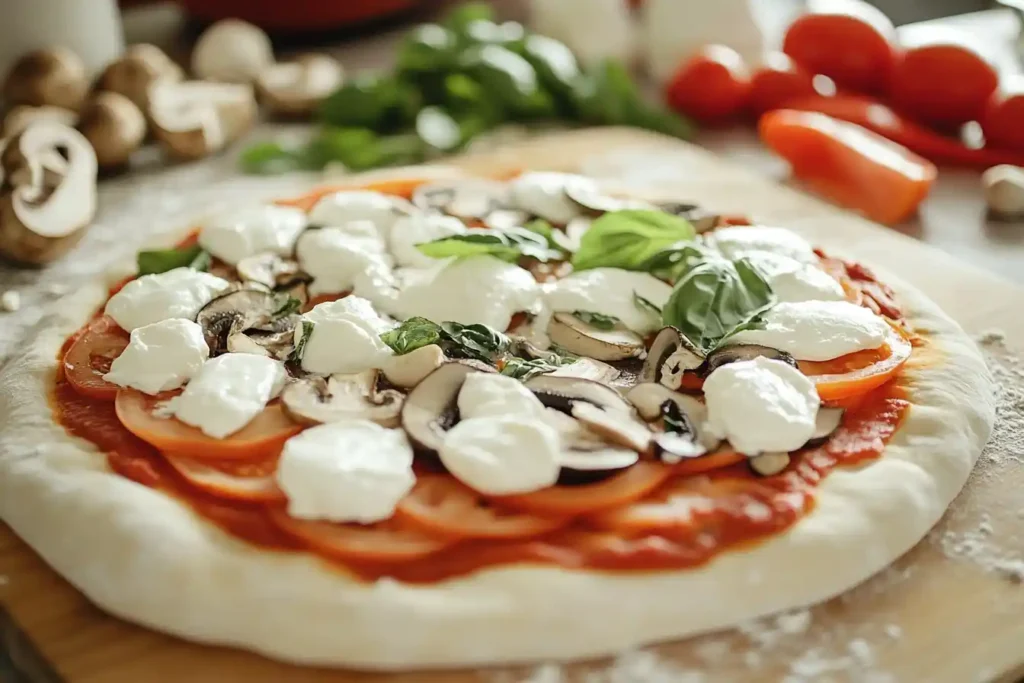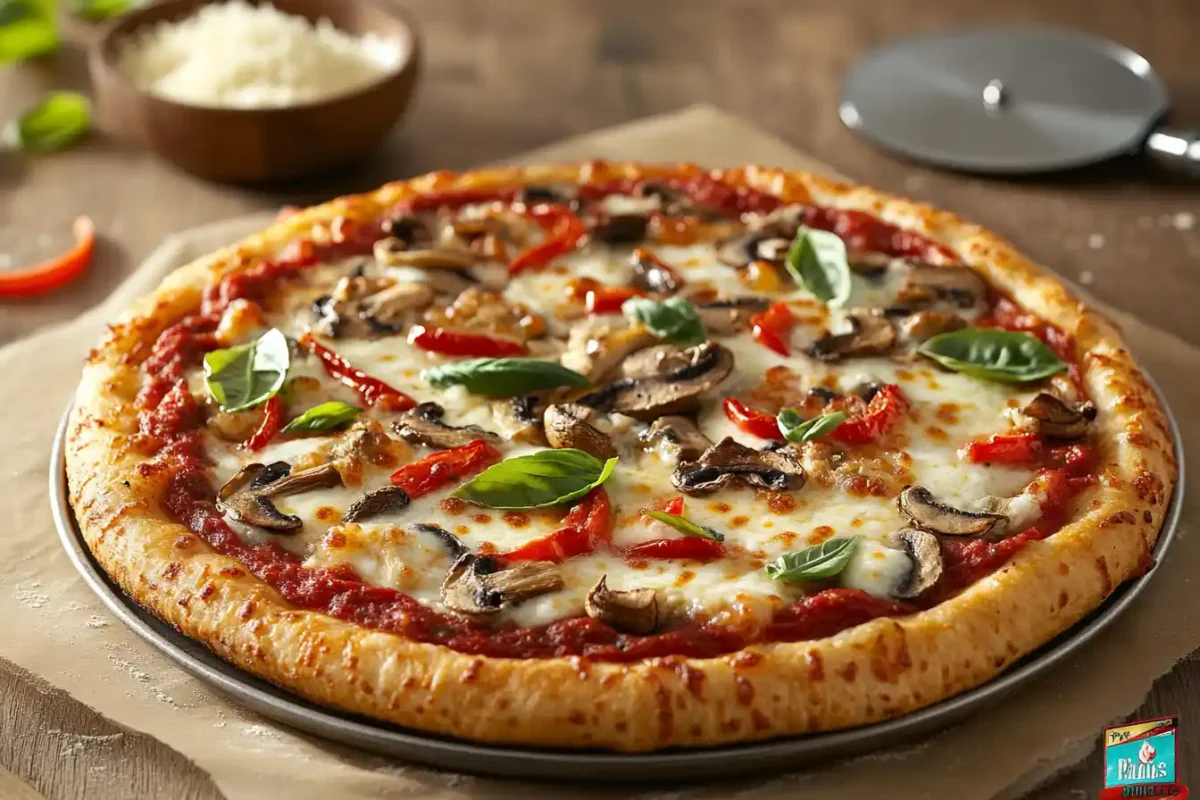Pizza nights at our house used to mean dialing up delivery—quick, but not always kind to the budget. One evening, though, I stumbled on a pack of premade pizza dough at the store while trying to pull together an affordable, last-minute dinner. I figured, why not give it a try? That simple swap was a total game-changer for me. Now, homemade pizza has become one of our favorite family dinners, and the best part? It’s easier (and cheaper!) than ordering out.
Using premade dough cuts the fuss without losing any of the fun or flavor. You skip the messy kneading and long rise times, but still get that crispy, golden crust that makes pizza so satisfying. Plus, everyone can pile on their favorite toppings, which turns dinner into a fun, customizable experience. Whether we’re making a classic cheese pizza or experimenting with leftovers from the fridge, it’s become a go-to meal on busy nights.
In this guide, I’ll walk you through choosing the right premade dough, prepping it for baking, and adding delicious toppings that make your pizza feel totally homemade—without the stress!
Why Use Premade Dough for Pizza
Convenience of Using Premade Dough in Pizza Recipes
Using premade dough is one of the simplest ways to make a delicious pizza at home without the fuss of making dough from scratch. It’s perfect for busy weeknights when time is limited, and it’s a reliable option that ensures consistency in every pizza you make.
Premade dough can be found in most grocery stores, making it a great solution for those moments when you crave homemade pizza but want to skip the complex preparation steps. By opting for premade dough, you’ll have more time to focus on the fun part—adding your favorite toppings!
Versatility
Premade dough is not just convenient—it’s incredibly versatile. You can choose from a variety of options, including refrigerated dough, frozen dough, or even specialty options like gluten-free and whole wheat. This versatility allows you to experiment with different crust textures and flavors to suit your taste.
Additionally, with premade dough, you can prepare more than just pizza. Think calzones, garlic knots, or even dessert pizza—all with minimal effort. This flexibility makes it a perfect choice for anyone looking to get creative in the kitchen without spending hours making dough from scratch.
Cost-effectiveness
Making pizza at home with premade dough is not only cost-effective but also allows you to control the quality of your ingredients. You can use fresh produce, premium cheese, and other quality ingredients without the hefty cost of ordering from a restaurant. By keeping a few dough packages in your freezer, you’ll always have an affordable base for a quick meal.
Choosing the Best Premade Dough for Your Pizza Recipe with Premade Dough
Exploring Different Types of Premade Pizza Dough
When selecting premade pizza dough, it’s helpful to understand the different types available so you can make the best choice for your recipe.
- Refrigerated Dough: Available in the deli or dairy section, this dough is easy to work with and quick to prepare.
- Frozen Dough: Usually found in the frozen foods aisle, it offers a longer shelf life but requires time to thaw.
- Specialty Dough: Gluten-free, whole wheat, or cauliflower dough options are available for those with dietary preferences or restrictions.
How to Choose the Right One
When choosing the best dough, consider the texture and taste you prefer. For example, if you like a chewy crust, opt for a dough with high-gluten flour. If you need a gluten-free alternative, there are now several great premade options available in stores, such as Udi’s Gluten-Free Dough, which provides a similar texture to traditional pizza dough.
Preparing Premade Dough for Your Homemade Pizza Recipe
Thawing and Handling Premade Dough
If you’re using frozen dough, make sure to thaw it properly. Ideally, take the dough out of the freezer and let it thaw in the refrigerator overnight. This slow thawing ensures that the dough remains elastic and easy to work with. If you’re short on time, leaving it at room temperature for a few hours will also do the trick.
Handling sticky dough can be challenging, but by dusting your work surface with flour or a bit of cornmeal, you can prevent it from sticking. Additionally, using olive oil on your hands will help keep the dough manageable.
Rolling and Shaping Premade Dough for Perfect Pizza
Rolling out premade dough should be done gently to avoid tearing. Start by pressing the dough into a flat circle with your hands before using a rolling pin. Alternatively, stretch it by hand for a more rustic look. If you want a round pizza, make sure to rotate the dough as you stretch it.
If you’re making a deep-dish pizza, press the dough into a greased pan and let it rest for a few minutes to settle. This approach ensures that the dough will hold the shape of the pan, creating that desired thick crust.
Prebaking the Dough
For a crispy base, prebaking your pizza dough is essential. Prebaking prevents the crust from becoming soggy when toppings are added. Simply place the rolled dough onto a parchment-lined baking sheet or pizza stone and bake at 450°F for 5-7 minutes. Afterward, let it cool slightly before adding your sauce and toppings.
Perfect Toppings and Sauce for Your Pizza Recipe with Premade Dough

Choosing the Perfect Sauce for Pizza with Premade Dough
The right sauce makes all the difference in your pizza. Classic tomato sauce is always a favorite, but you can also explore other options such as white sauce, pesto, or even barbecue sauce for something different.
When applying the sauce, less is more. Overloading the pizza can lead to a soggy crust. Spread a thin layer of sauce, leaving about an inch of space around the edge for the crust to rise.
Best Cheese Choices for Pizza Recipes with Premade Dough
Mozzarella is the most commonly used cheese for pizza, but mixing in other varieties can enhance the flavor. Parmesan, fontina, or even goat cheese add complexity and depth to your pizza. If you’re looking for a unique twist, try using smoked mozzarella for a more intense flavor profile.
Popular Topping Combinations
There are endless topping combinations to explore. Here are a few tried-and-true favorites:
- Classic Margherita: Fresh mozzarella, basil, and a drizzle of olive oil.
- BBQ Chicken: Barbecue sauce, cooked chicken, red onion, and cilantro.
- Veggie Lovers: Bell peppers, mushrooms, olives, red onions, and spinach.
To keep your pizza balanced, limit the number of toppings. Too many toppings can weigh down the crust, leading to an uneven bake. Aim for a combination of three to four toppings that complement each other.
Cooking Your Pizza
Cooking Your Pizza Made with Premade Dough
The cooking method you choose significantly affects the final product. Baking on a pizza stone is one of the best ways to achieve a crispy crust because it absorbs moisture, preventing sogginess. If you don’t have a pizza stone, a baking sheet works as well—just make sure it’s preheated.
Alternatively, you can cook your pizza on the grill for a smoky flavor or use an air fryer for a personal-sized pizza with a crispy edge.
Time and Temperature
The optimal temperature for baking pizza with premade dough is between 450°F and 500°F. Baking at a high temperature ensures that the crust cooks quickly and the cheese melts evenly. Depending on your oven, it usually takes about 10-15 minutes.
If you notice the cheese browning too quickly, cover the pizza loosely with aluminum foil to prevent it from burning while the crust finishes baking.
Enhancing Premade Pizza Dough Flavor
Seasoning the Crust
To elevate the flavor of your premade pizza dough, season the crust before baking. Brushing the crust with olive oil, then sprinkling it with garlic powder, Italian seasoning, or Parmesan cheese will add a delightful burst of flavor.
Adding Texture
For a crispy crust, brush it with butter or olive oil right before baking. You can also sprinkle coarse sea salt or cornmeal along the edges for added texture. These simple touches can take your pizza from ordinary to extraordinary.
Common Mistakes to Avoid in Pizza Recipe with Premade Dough
Overcrowding Toppings
Adding too many toppings can overwhelm the pizza and result in a soggy crust. The moisture from the toppings can prevent the dough from cooking properly, leading to an uneven texture. Instead, focus on selecting a few high-quality toppings that complement each other. This allows each ingredient to shine and keeps the pizza balanced.
When adding toppings, remember that less is often more. A thin layer of sauce, a moderate amount of cheese, and a few toppings will ensure that the pizza crust stays crisp and everything cooks evenly. Think of it as letting each ingredient have its moment to stand out.
Using Cold Dough
One common mistake is using dough that is too cold. Cold dough is more difficult to work with and tends to shrink back when you try to roll or stretch it out. Always allow the dough to come to room temperature before you start shaping it. This will make it much easier to handle and will also help it bake more evenly.
To avoid this issue, take your premade dough out of the refrigerator at least 30 minutes before you start working with it. Letting it rest at room temperature will make it more pliable, resulting in a better crust texture.
Cooking at the Wrong Temperature
Cooking your pizza at too low of a temperature can result in a crust that is tough and toppings that are undercooked. High heat is key to achieving that perfect, crispy crust with bubbly cheese. Always make sure to preheat your oven to at least 450°F, and ideally closer to 500°F.
Another mistake is not preheating the oven long enough. Even if your oven reaches the desired temperature, it’s important to let it continue heating for an extra 10-15 minutes to ensure that the entire oven, including the walls and racks, is evenly heated. This consistent heat will help your pizza bake more evenly, resulting in a crust that is crispy on the outside and soft on the inside.
Not Using Enough Flour or Cornmeal
When rolling out your pizza dough, it’s crucial to use enough flour or cornmeal on your work surface to prevent the dough from sticking. If the dough sticks, it can tear when you try to lift it, and it can also become difficult to transfer to your baking sheet or pizza stone.
Additionally, using a sprinkle of cornmeal on your baking surface can help create a barrier between the dough and the pan, adding a bit of extra texture and helping to prevent sticking. This small step can make a big difference in ensuring your pizza slides off easily after baking.
Not Letting the Dough Rest After Shaping
Once you’ve rolled out or shaped your pizza dough, it’s a good idea to let it rest for a few minutes before adding your toppings. This resting time allows the gluten to relax, which helps prevent the dough from shrinking back and ensures a more consistent bake.
If you rush this step, you might find that the dough pulls away from the edges or becomes uneven in thickness, which can lead to parts of the pizza cooking faster than others. Allowing just 5-10 minutes of rest can make a noticeable difference in the quality of your finished pizza.
Frequently Asked Questions
Should You Prebake Pizza Dough Before Adding Toppings?
Yes, prebaking helps create a crispy base and prevents the crust from becoming soggy under the toppings. It’s especially important if you’re adding a lot of toppings or using wet ingredients like fresh tomatoes or mushrooms.
Does Premade Pizza Dough Need to Rise?
Most premade doughs don’t require additional rising. However, if you want a thicker crust, let the dough rest at room temperature for 15-30 minutes before rolling it out. This allows the gluten to relax and makes the dough easier to shape.
How Do You Use Ready-to-Use Pizza Dough?
To use ready-made dough, start by thawing (if frozen), then roll it out on a floured surface. Prebake the dough, add your desired sauce, cheese, and toppings, and bake until the crust is golden and the cheese is bubbly.
How to Make Premade Pizza Crust Taste Better?
To improve the taste of premade crust, season the dough before baking. Brush with olive oil or melted butter and sprinkle with herbs, garlic powder, or grated cheese for added flavor.
Conclusion
Making pizza at home with premade dough is an easy and rewarding experience. It allows you to enjoy a freshly baked pizza tailored to your tastes, all while saving time and effort. Whether you prefer a classic Margherita or a creative combination of toppings, premade dough provides a versatile base for delicious results. So next time you’re craving pizza, skip the delivery and try making your own—you might just find it even more satisfying!
Print
Easy and Delicious Pizza Recipe with Premade Dough
- Total Time: 25 minutes
- Yield: 4 servings 1x
Description
🍕 Craving homemade pizza without the hassle? This easy and delicious pizza recipe uses premade dough, so you can enjoy a fresh, hot pizza in under 30 minutes! Customize with your favorite toppings and enjoy a crispy, cheesy slice anytime.
Ingredients
1 premade pizza dough (store-bought)
1/2 cup pizza sauce
1 1/2 cups shredded mozzarella cheese
1/2 cup sliced pepperoni (optional)
1/4 cup sliced bell peppers
1/4 cup sliced red onions
1/4 cup sliced mushrooms
1 tablespoon olive oil
1 teaspoon Italian seasoning
1/2 teaspoon garlic powder
Instructions
- Preheat your oven to 425°F (220°C).
- Roll out the premade pizza dough on a floured surface to your desired thickness.
- Transfer the dough onto a greased pizza pan or baking sheet.
- Brush the dough lightly with olive oil.
- Spread pizza sauce evenly over the dough, leaving a small border around the edges.
- Sprinkle mozzarella cheese over the sauce.
- Add toppings: pepperoni, bell peppers, red onions, and mushrooms, or any toppings you like.
- Season with Italian seasoning and garlic powder.
- Bake for 12-15 minutes, or until the crust is golden and the cheese is bubbly.
- Remove from the oven and let cool for a couple of minutes.
- Garnish with fresh basil leaves if desired.
- Slice and serve warm!
Notes
- You can use whole wheat or gluten-free premade dough if preferred.
- Swap mozzarella for a mix of cheeses like provolone, parmesan, or cheddar for extra flavor.
- For a crispier crust, bake directly on a pizza stone or oven rack.
- Prep Time: 10 minutes
- Cook Time: 15 minutes
- Category: Dinner
- Method: Baking
- Cuisine: Italian
Nutrition
- Serving Size: 1 slice
- Calories: 320 kcal
- Sugar: 3g
- Sodium: 780mg
- Fat: 14g
- Saturated Fat: 6g
- Unsaturated Fat: 6g
- Trans Fat: 0g
- Carbohydrates: 34g
- Fiber: 2g
- Protein: 14g
- Cholesterol: 35mg
Keywords: easy pizza recipe, premade dough pizza, homemade pizza, quick pizza recipe

